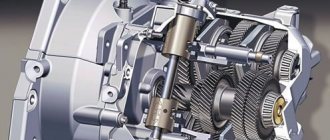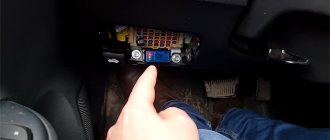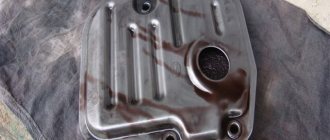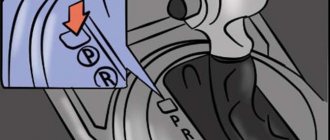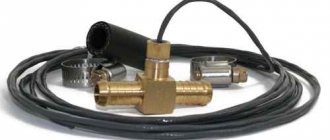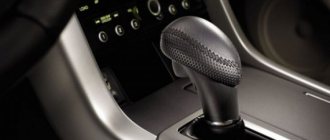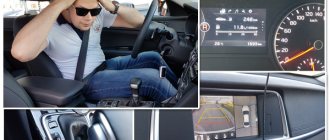Some automatic transmissions have selector positions that you almost never use. In what cases are they necessary or dangerous, and why modern machines got rid of them.
Automatic transmissions have gone through many improvements throughout their history. The number of planetary gears changed, new stages and operating modes were added. And with the entry of new generations of transmissions onto the market, control has also become simpler. Therefore, for some drivers switching from a new passenger car to a used SUV, or vice versa, strange inscriptions on the slot of the automatic transmission lever raise questions. Why are there numbers 2, 3 or the Latin letter L, as well as an additional button on the side in the shape of a snowflake?
Photo: Shutterstock.com
What is an automatic transmission
What is an automatic transmission - this is an abbreviated name for Automatic Gear Shift, it allows the driver not to change gear manually when the car picks up speed or reduces it, smart electronics does it for him, choosing the optimal moment to engage an upshift or the moment to engage a downshift, the driver remains just select the direction on the shift selector forward or backward and press the brake or gas pedal depending on the need, there is no clutch pedal with such a box, there is only gas and brake.
Here, for example, are ordinary photos of some types of automatic transmissions in automobile gearboxes. For many mechanical enthusiasts, these symbols do not mean anything, but only confuse them more and distance them from the automatic transmission.
Therefore, let's try to dispel the fog of doubt and ignorance by explaining the meaning of each symbol on the automatic transmission:
- R – translated in English as Parking, parking or parking. The car is switched to this mode only after a complete stop. If you are standing on a hill, it is recommended to first put the car on the handbrake and only then move the lever to the Parking position, after which you can leave the car and go about your business
- R - literally Reverse, back, back - that is, normal reverse gear, engage it when there is a need to drive in reverse
- N - translated as Neutral, that is, neutral, neutral speed, it is mainly used for towing a car, usually when standing in a traffic jam, it is recommended to hold the brake pedal without moving the car to the neutral position - since this is not a manual transmission, but nevertheless, many automatic transmission owners when parking, especially in traffic jams, move the lever to position N , because you must admit that keeping your foot on the pedal for 20-30 minutes is not at all comfortable
- D or A – you can find both of these designations Drive or Automate, which is essentially the same thing, that is, you switch to this position when you need to drive, squeeze the brake, put the speed lever in position D or A and simply press the gas pedal, smoothly releasing the brake pedal and all movement has begun, now there is no need to switch with the handle, you simply regulate the speed of your movement by pressing the gas pedal with your foot in your car
- L or B (l, 1, 1L) – some types of automatic transmissions are equipped with additional functions (Low or Bottom), which can literally be translated as slow or first gear. Typically used on ice, very steep descents or uphills, or for engine braking.
- B or simply Block often means differential locking, usually on jeeps or all-wheel drive cars, in which cases it is better to read the manual for your car model
- 2 or 2L, 3 or D3, 4 or D4 – means limiting the speed switching by the gearbox, that is, set it to 2 - it means the box will not shift above the second gear no matter how hard you press on the gas, set it to mode 3 - the box will not shift above the third gear no matter what you do with the accelerator pedal, the same and 4 - shifting will not occur above the fourth speed, for example, you have 6 gears in the box, you set it to mode 4 - this means the car itself will shift from 1st to 4th gear, the car will not shift to 5th and 6th
Such buttons can be either on the shift knob itself or near it:
- OD - or known as (Over Drive) is similar to mode 3 or D3 - made so that when driving, for example, at a speed of 60-80 km/h, your transmission constantly clicks, switching from 3 to 4 and vice versa from 4 to 3 gear, so that this did not happen, turn on the OD , in fact, this mode automatically activates mode 3, which means you will move in 3rd gear
- M - translated as Manual, that is, manual control, you can choose when to turn on and what speed to turn on in your car, this is usually done with the + and - buttons either on the speed lever or on the steering wheel or with the paddles behind the steering wheel or under the steering wheel
- S – or otherwise (Sport) not all gearboxes are equipped with it, sport mode implies more active movement and speed gain, which, of course, will affect fuel consumption
- W or Snow sometimes also draw a snowflake - which means (Winter) in our winter mode, puts the box into a very smooth starting mode so as not to shovel snow under you and sit on your belly
- E – can be translated (Economic) as economical, the car will not be too playful, but fuel will be consumed significantly less
- KickDown - or “gas to the floor”, many have probably heard this expression, it exists so that when the gas pedal is pressed sharply and completely to the floor, the box switches to one or two gears lower for a very quick increase in speed, used when overtaking or, when you don't have time to stop overtaking
This is interesting: What is the ground clearance of Kalina station wagon?
Mode “S” on an automatic machine: what it means and what it’s for
In modern automatic transmissions, in addition to the main and reduction modes of operation, there are additional ones, the use of which depends on the operating conditions of the vehicle, driving style, etc. The modes are activated through software commands written in the electronic control unit of the automatic transmission.
One of these modes is the “S”, “Power” or “PWR” (Sport) mode. The S position on the automatic transmission can be different - in one case this solution is implemented using a button, in another case through an additional position of the automatic transmission selector.
In sport mode, shifting to higher gears is carried out at maximum engine speeds. Compared to normal driving, when the “S” mode is turned on, the driver will be able to feel the difference: the car begins to respond faster to pressing the accelerator pedal, picks up speed more intensively, and on many cars the steering becomes “sharp.”
The maximum effect when driving in sport mode is provided by the exchange rate control system (ESP). It allows for minimal controlled drift of the car's axle, allowing the driver to feel like he's driving a sports car.
At the same time, the exchange rate stability system allows you to drive the car more aggressively, but nothing more. In other words, no electronics can provide complete safety for the driver and the vehicle.
Article on the topic: Design of a diesel engine turbine
Some manufacturers, making driving a car as easy as possible, install an adaptive system that adapts to the driver. The system recognizes up to ten predicted situations:
- uniform movement along the highway,
- acceleration, acceleration or braking on a bend, etc.;
Depending on the current situation, if the driver does not make adjustments to the ECU operating algorithm in time, the system will automatically turn on or off the sport mode.
Range P (Park) - parking mode.
This mode is selected when the car is parked for a long time. In this position, the controls in the box are disabled, the output shaft is blocked, and as a result, the machine cannot move (the drive wheels are blocked, the blocking is not associated with the parking brake and is located inside the box itself). Starting the engine in this mode is allowed.
Do I need to use the parking brake when parking? On flat areas, provided that it is in good working order, blocking the output shaft of the box for reliable fixation is quite sufficient. When stopping on a slope, it is advisable to use the parking brake. In this case, you first need to pull the handbrake, and only then put the gear shift lever in P mode. Thus, you remove additional load from the locking mechanism of the output shaft of the automatic gearbox.
How to properly use low-range L gears on an automatic transmission?
The first generation automatic transmissions, which did not yet have manual speed control, used a special design with reduction gears. Many drivers simply do not understand why downshifts are needed on an automatic transmission and how to use such a gearbox correctly. Let's take a closer look at what downshifts are used for on an automatic transmission.
A short note on how to start driving with an automatic transmission
- Put the lever in position P or parking
- Turn the key in the ignition and start the car engine
- Squeeze the brake and, holding it pressed, set the lever to position D drive.
- Gently release the brake and add gas and start moving.
- Remember that when changing any position of the speed lever you must depress the brake pedal
- Also, on the automatic transmission, it is highly not recommended to tow anyone or pull a trailer - you are overloading this automatic transmission, which will lead to its rapid wear or even failure immediately at the time of towing
- With an automatic transmission, towing a stalled car is carried out in the N neutral lever mode, and the towing itself can be done at a distance of no more than 50 km at a speed of no higher than 30 km.
Range R (Reverse) - reverse mode.
An attempt to engage the R mode while moving forward will inevitably lead to damage to the automatic transmission and other transmission elements (on cars whose transmissions do not have the appropriate locking, it is strictly contraindicated to engage the R mode until a complete stop). It is also impossible to start the engine if the gear shift lever is in this position. Four-speed automatic transmissions for forward driving have four modes: D, 3, 2 and 1 (L). It should be noted here that starting the engine is impossible if one of the listed modes is turned on.
New management
But with the entry of improved transmissions onto the market, the need for the listed modes has disappeared. Now automatic machines have electronic control units that are trained to recognize slipping and even movement on various sections of roads with variable surfaces. Electronics corrects the operation of components and assemblies if it senses ice, snow or gravel under the wheels. In addition, many automatic transmissions now have a manual mode, allowing you to select gears yourself and change them as needed. The on-board electronics also contain programs for movement in various environments. If you set the off-road driving program, the computer will reconfigure not only the automatic transmission, but also the accelerator, engine, steering and even suspension. In this case, the box will only work at lower levels. Thus, mode L is no longer relevant, and it has been removed from the scene.
Article on the topic
Why does an automatic machine need N mode and how to use it correctly?
In sport mode, the gearbox will automatically change gears only after the engine reaches maximum traction speed. And when the “Snow” mode is activated, the transmission will launch a gentle program: it will start from second to avoid slipping, but will not allow activating the higher stages at speeds from 40 to 80 km/h in order to maintain traction on the wheels to counteract possible yaw of the car.
In general, the functionality of automatic transmissions has expanded significantly, and the need for the old modes 2, 3 and L has disappeared. However, they are still found on used cars or on licensed copies of old transmissions, which can be seen on Chinese vehicles. They are also found on old frame SUVs that have not been updated for more than 10 years, which come with old proven transmissions coupled with a reduction gearbox and mechanical differential locks. New electronic boxes are contraindicated for such machines.
Range D (Drive) is the main mode for moving forward.
This mode performs automatic sequential gear shifting (in this mode, all gears are usually involved except for upshifts). This mode is recommended under normal driving conditions. Range 3 (Number 3 on some types of automatic transmission) - the first three gears are engaged while driving. This mode is active, it is great for city driving, and turns off when the ignition is turned off. Especially at high operating speeds of the automatic transmission, it will not be possible to save fuel; this mode does not allow the torque converter clutch to be repeatedly locked and unlocked in rough city driving conditions (no more than 80 km/h), and is also partially blocked when switching to higher gears. Most suitable for driving when frequent stops are inevitable and for driving on roads with ups and downs. Engine braking is possible in this mode. Range 2 (Number 2 on automatic transmission) - in this mode, driving is only allowed in second and first gear. Most suitable for use on winding mountain roads. Switching to fourth and third gear is prohibited. Range 1 (L or Low) - low gear. In this mode, driving is only allowed in first gear. The traction capabilities of the engine in this range are realized to the maximum, since the torque transmitted to the wheels only in first gear is maximum. Engine braking is especially effective in this mode. Driving on steep descents and ascents must be done in first gear.
Overdrive (O/D)
Some automatic transmissions have a mode in which automatic upshifting is possible. The O/D (Overdrive) button is used to activate this automatic transmission mode . Its recessed position when the Drive mode is on allows you to switch to a higher gear. If you release this button, switching to the last gear will again become impossible. The O/D OFF indicator indicates the status of the control system. If the indicator is on, then using the Overdrive mode is impossible, but otherwise there is such a possibility.
It is recommended to use overdrive mainly on the highway for more economical and measured movement. Interestingly, some four-speed automatic transmissions (for example, (Toyota)aisin 241e) can disable 4th gear with gear ratio 1, which is not an overdrive!
One of the differences between an automatic transmission and a manual transmission is the inability to perform engine braking in each mode. In overrunning clutches, in modes that do not allow engine braking, the transmission slips and the car coasts. And when driver position 1 is selected, engine braking is applied in first gear. In the first gear in position D, such braking is impossible.
Extending the life of automation
First of all, the performance potential of the automatic transmission is determined by careful operation. An important factor that prolongs the durability of the mechanism is timely and high-quality maintenance.
The duration of a comfortable ride on an automatic transmission will be longer if you constantly monitor the oil level in the box. Using a dipstick from the engine will help sort this out. The main thing is to prevent leaks by changing the oil and filter. It is advisable to do this every 40–60 thousand km. Also, do not save money; it is better to use the original product.
In terms of operation, automation is many times more complex than mechanics. Moreover, such a transmission is more suitable for traveling around a metropolis. There’s just a nuance: the machine doesn’t like high overloads. Do not torture the system until it warms up. This is especially true in winter.
Once you change from a manual to an automatic, you can confidently say: you won’t change back.
Source
How to properly start a car with an automatic transmission?
As a rule, automatic transmission breakdowns are often caused by their improper maintenance and use. After starting the engine, so that the automatic gearbox is in working condition, you must wait about a minute before starting to drive. Before you start driving, without pressing the throttle pedal, you must depress and hold the brake pedal while putting the gear shift knob in mode D or R. After waiting for a slight push, you can start moving by releasing the brake pedal and pressing the accelerator pedal with your foot. Dynamic driving should be avoided for some time after starting to move, so that the oil in all components and assemblies reaches its operating temperature. Before you start driving, in order to more effectively warm up the automatic transmission, the handle of the gear shift control lever must be moved to different positions, lingering in each of them for a while. Then, by turning on one of the driving modes and pressing the brake, hold the car in place for a couple of minutes, during which time the engine should be running in idle mode. At low ambient temperatures in position R, starting to move without completely warming up the automatic gearbox is unacceptable, because this (due to the high viscosity of the fluid in the transmission) can damage the planetary mechanism.
Automatic transmission how to use video
Towing a car with automatic transmission
A faulty car is towed in N mode, but do not forget that cars with automatic transmission can only be towed over relatively short distances. Due to the fact that the oil pump is also inactive when the engine is not running, the lubrication of the components and elements of the automatic transmission is significantly deteriorated. All of the above is relevant when transporting a car over long distances. Therefore, if there is a need to transport your faulty vehicle with an automatic transmission, this must be done at a speed not exceeding 70 km/h. and at a distance of no more than 70 kilometers. Otherwise, it would be ideal to use a tow truck.
Is it possible to slip with an automatic transmission?
It is more difficult to stall in a car with an automatic transmission than in a car with a conventional manual transmission. But if this does happen, then “rocking” the car by switching the gearbox from forward to reverse and vice versa is simply unacceptable. In this case, you need to use the lower range, it eliminates switching to higher gears, and in this mode try to overcome the muddy area using the brake as a clutch. In almost the same way (without over-throttle and playing along with the brakes) they perform maneuvers in a confined space.
Is it possible to change automatic transmission speeds while driving?
Switching driving modes on the go is allowed, but not in all positions. So, for example, it is unacceptable to turn on modes P and R when moving forward. These modes are activated when the vehicle is completely stopped. Neglecting this rule will inevitably lead to serious malfunction of the automatic transmission. It is also undesirable to put the gear shift lever in N mode while driving, because in this mode the connection between the engine and the wheels is disconnected and in case of sudden braking it can lead to the car skidding. You can switch the automatic transmission to any other mode while driving. In some cases, this is even necessary. For example, switching from mode 3 to mode 2 increases engine braking efficiency.
How to drive a car with an automatic transmission
Since the 1980s, the automatic transmission has switched from hydraulic to electronic control, and the more modern the model, the more complex and capricious the transmission, although it becomes “more interesting” to drive. For novice drivers, it will be useful not only to learn the rules for controlling an automatic transmission, but also to understand its structure and operation.
Let's look at how to learn to drive an automatic transmission using two pedals and a mode selector.
Starting the engine with automatic transmission
Starting an engine with an automatic transmission has the following features:
- In a car with automatic transmission there are only two pedals: “brake” and “gas”
. Therefore, the driver's left leg is practically not used. When starting the engine, the gas pedal is not pressed, but in some brands of cars the brake pedal must be pressed, otherwise the engine will not start (read the operating manual). However, driving instructors advise making it a rule to always press the brake pedal before starting the engine with an automatic transmission. This will prevent the car from spontaneously moving in neutral mode “N”, and will also allow you to quickly switch to driving modes “D” or “R”. (It will not be possible to switch to the indicated modes and move away without pressing the brake pedal). - In cars with automatic transmission, protection is provided - automatic blocking of engine starting if the gear shift lever is in the wrong position
. This means that an engine with an automatic transmission can only be started if the gear shift lever is in one of two positions: either “P” (park) or “N” (neutral). If the PP lever is in any other position intended for movement, the locking protection against incorrect starting will be activated. This protective function is very useful, especially for beginners, and especially in cities with high “car density”, where cars are parked closely together in parking lots and in traffic. After all, even experienced drivers sometimes forget to “decelerate the car” before starting the engine, as a result of which, when starting, the car immediately starts moving and crashes into the nearest car or obstacle. You can start the engine with an automatic transmission in both “P” (parking) and “N” (neutral) modes, but manufacturers recommend using only “P” mode. Therefore, it is better to set one more rule for yourself - park and start the engine only in “parking” mode. - After turning the key in the ignition before starting the starter, it is recommended to wait a few seconds
to give the fuel pump time to turn on and pump up the compression.
It should be remembered that on some brands of cars with automatic transmission, gear shifting is impossible without inserting and turning the key in the ignition (unlocking the gearbox). Also, on some brands it is impossible to remove the key from the ignition switch if the PP lever is in the “D” position. (Read the instruction manual).
Starting and stopping with automatic transmission
Most drivers who switch from a manual to an automatic transmission initially automatically perform actions that they are accustomed to performing repeatedly when driving a car with a manual transmission. Therefore, before starting to drive with an automatic transmission on the road in general traffic, such drivers are advised to first practice alone. So, the standard procedure for starting a car with an automatic transmission is as follows:
- Insert the key into the ignition.
- Depress the brake pedal with your right foot (the left foot is not used when driving with an automatic transmission).
- Check the position of the gear shift lever - it should be in the “P” - “parking” position.
- Start the engine (with the brake pedal pressed).
- Also, with the brake pedal pressed, switch the PP lever to position “D” - “drive” (moving forward).
- Fully release the brake pedal, after which the car will move off and begin to move forward at a low speed - about 5 km/h.
- To increase the speed, you need to press the gas pedal. The harder you press the gas pedal, the higher the gears and speed will be.
- To stop the car, you need to remove your right foot from the gas pedal and press the brake pedal. The car will stop.
- If you plan to leave the car after stopping, then with the brake pedal pressed, move the gear lever to the “P” - “parking” mode. If you need to stop in a traffic jam, at a traffic light or a pedestrian crossing, then, naturally, there is no need to switch the PP lever to “parking”. Once you decide to continue driving again, release the brake pedal and press the gas pedal to increase speed.
Designations
For those who have previously driven a manual car, the letter designations may not seem clear at first glance. However, it is not at all difficult to understand them, because the letters indicate the operating modes of the box, and the first letters of foreign words indicate the action that the driver is going to perform. There may be more or less, but we will now look at the main ones:
- P – parking mode;
- R – reverse;
- N – neutral gear;
- D – main mode, driving mode (in some cars this is “A”);
- Numbers from 2 to 4 – indicate movement in a gear not higher than one of the selected gears;
- L – low gear (in some car models this is “B”);
- M – mechanical gear shift, by moving the lever to “+” or “-”;
- S – sport mode;
- E – economical mode;
- W – winter mode (can be indicated by a snowflake, the word SNOW or HOLD). This mode cannot be turned on in summer, and often used in winter. The box may overheat and burn;
- OD – overdrive;
- KD – low gear, engages independently when you press the gas fully, provides a quick increase in speed.
These are just some of the symbols that you may encounter, and unlike a manual transmission, which you can learn to shift in a couple of days, you will need to become thoroughly familiar with an automatic transmission. The user manual will help you with this.
Before the start
All car owners know that on a manual transmission you need to move the lever to first speed before starting to drive. For an automatic transmission, there is a procedure that will help maintain its performance for a long time, which should be carried out before driving off:
- Before starting the engine, the handle must be in position “P” or “N” . Otherwise, the car may not start or your gearbox will simply break;
- After starting the engine, stand still and move the handle to all possible positions, holding each position for several seconds. This will warm the box up to operating temperature. After that, you should turn on mode “D” and hold the car with the brake for a couple of minutes without touching the gas pedal.
Now the car is ready to start, you can move off.
Turn on the "lower"
By starting a low-range gear, a large torque is transmitted to the wheel drive. As a result, difficult roads can be overcome without serious load on the engine.
This mode is not the only one on modern machines. The driver can also select other operating modes. You can save fuel while traveling on highways by switching the gearbox to high-speed operation. We often encounter the problem of traffic jams; in such a situation, it is logical to switch the gearbox to a mode not exceeding first gear. Typically this setting is used when driving at low speeds.
Movement
Before you start driving, it’s worth understanding a couple of rules related to an automatic transmission and starting to drive on it:
- Before moving the handle from the “P” and “N” positions to the “D” position, press the brake pedal, this will reduce the idle speed. As soon as you feel a characteristic push, you can switch to driving mode and smoothly press the gas;
- You shouldn't start driving hard right after you start driving. The oil is still cold at these moments, and the box can be damaged;
- If you're just getting used to an automatic, try to resist the temptation to stick to the manual. This may damage the transmission if you have just started driving;
Try to drive in “D” or “3” mode when in the city and turn on “OD” mode as little as possible. On climbs and when moving along difficult sections of the road, use “2”.
While driving, it is not allowed to engage the parking and reverse modes until the vehicle comes to a complete stop. Neutral speed can only be switched on in emergency situations when engine braking occurs. If you accidentally switch to one of the unacceptable modes, it is recommended to reduce the speed to idle. Then put the car back into driving mode.
If your car has modes “3”, “2” and “1”, then you can perform engine braking. This is done like this:
- While in mode “3”, release the gas pedal;
- Move the knob to position “2”;
- After reducing the speed to 50 km/h, release the gas again;
- Move the handle to position “1” or “L”.
Please note that, even if you follow all the necessary rules, engine braking on cars with an automatic transmission is less effective than on a manual one. You should not rely on this method again.
To quickly gain speed, when accelerating, you should switch to position “2” and monitor the engine speed. If there is a sports mode, the shortest acceleration time can be achieved in it. Also, when you press the gas pedal to the maximum, the “OD” mode will turn on, which will allow you to gain the greatest number of revolutions within each gear. The mode will turn off when you reach the maximum number of revolutions at maximum speed. It can be turned off by releasing the gas pedal. Please remember that using this mode will shorten the life of the box.
Winter driving on automatic
Installed modern car systems allow you to move from a place after a long period of inactivity in severe frosts. But this doesn't mean you need to rush. It would be better if you let the engine work without straining. Thus, when the oil mixture dilutes, the lubrication system is filled. As a result, the piston element will heat up. The manipulations will take no more than three minutes.
After starting the engine and pressing the brake pedal, you should move the automatic transmission to position D. This mode lasts about thirty seconds, then switches to reverse (R). Then you will have to wait a little, repeating these steps twice. The driver should lightly depress the gas pedal, initially holding the handbrake.
Proper movement on a snowy road requires maximum smoothness, without sudden acceleration and braking. A sufficient distance must be maintained between your car and the person driving in front. Don’t forget, when driving along a snowy road where there are often patches of ice, the activation of ABS will ensure that the vehicle moves in a straight line. At the same time, the braking distance will increase.
Stop
For short stops, it is necessary to hold the brake, but when moving the lever to the “P” position, it is not necessary to hold the brake. When stopping on roads with a slope, you must put the car on the handbrake, and this should be done before turning on the “P” mode.
When parking for long periods, it is necessary to turn on the “N” mode. It is good for traffic jams on hot days. In neutral gear the box cools down well. Driving a car with an automatic transmission, in conditions where frequent stopping is required, is much easier than a car with a manual transmission.
Towing
There is one important and rather sad aspect that concerns cars with an automatic transmission. Such vehicles can only be towed with the engine running and in neutral. As a rule, in situations where towing is required, the engine no longer works, so the question arises as to whether this can be done.
It is worthwhile to thoroughly familiarize yourself with the instructions for your car and try to find instructions on this matter. In modern cars, towing is possible in “N” mode for a distance of 50 km and at a speed not exceeding 50 km/h. Of course, the best option in such a situation would be to call a tow truck, and if you are not sure that towing is acceptable for your car, you should not risk it. Repairs will cost more than a tow truck.
Is it possible to tow with a car with an automatic transmission? Opinions also differ on this matter, but there are some rules that, if followed, can still be towed automatically:
- The car should weigh no more than your car with an automatic transmission;
- You can only tow in a low gear or in position “2”, while observing the speed limit of no more than 40 km/h;
- If we are talking about a light trailer, then you can tow it without fear of damaging the car;
- Do not resort to towing unless absolutely necessary.
Why is the reduced automatic transmission mode useful and how to use it correctly
Types of gearboxes have certain advantages and disadvantages. In the case of an automatic, it is more suitable for driving on city roads where moderate speed is required. Speaking of mechanics, there is good efficiency, thanks to which the driver feels his car to the fullest. It happens that when overcoming hills, it is difficult to choose the optimal gear. If you switch to third, the engine does not have enough power. When the second one is turned on, there is excessive thrust, leading to excessive engine consumption. This is where you can’t do without a lower gear.
In the cabin
The main element of the automatic transmission with which the car owner interacts is the automatic transmission selector. It is used to switch transmission modes, and you should know the symbols on the automatic transmission in order to select the correct mode and understand exactly how the automatic transmission works at the moment. Mode designations are often duplicated on the dashboard of modern cars.
A typical selector with notation:
Let's look at the main symbols on the automatic transmission
- Latin letter P: this is the beginning of the word Parking, indicating the parking/parking mode, which some car owners also call the parking brake.
In this mode, the vehicle's drive wheels are locked to prevent unintentional movement.
- The letter R. The word Reverse begins with it, meaning movement in the opposite direction.
Selecting R on the selector engages the reverse gear of the box.
- The letter N is a classic one, familiar to many from a manual “neutral” transmission.
In this mode, no force is transmitted to the wheels, but they themselves are not blocked.
Important: you cannot tow a car in N mode and with the engine turned off, or you can only do this for short distances and at low speed. Failure to comply with this rule will lead to failure of the automatic transmission.
- Letter D
This is the so-called Drive, the main mode of the box, in which normal movement is carried out.
- Letter A.
Sometimes you see this designation instead of D, and it means the same thing - normal movement mode.
- Designation on the automatic transmission L.
It indicates the engagement of a low gear (Low), which is useful for overcoming obstacles on the road. The engine braking function is activated to help the driver safely navigate steep descents.
Important: on some all-wheel drive vehicles, L activates the differential lock mode, and you can switch to it only after stopping the car. The meaning should be clarified in the instructions for the machine. In addition, sometimes not a lowercase L, but a capital l is used, which can mislead the car enthusiast.
- B – from the word Bottom, another possible designation for a low gear.
Important: the letter B on the selector can have different meanings. For example, in some models it means turning on the differential lock, and selecting this mode while driving is strictly prohibited. It is necessary to clarify the specific meaning in the instructions for the car.
- Digit 2: selecting this mode limits the maximum possible gear to the 2nd transmission stage.
- Number 3: a similar limitation, but the “ceiling” of gears is the third.
Why do you need a gearbox with low gear?
Let's imagine a situation where, during a long climb in third gear, the engine does not have enough power to overcome an obstacle, and when switching to second gear, the number of revolutions is high.
Then the downshifts come into effect. The car starts to move at high speeds, but at low speed. At the same time, engine power increases, and overcoming road obstacles becomes easier. A low-range gearbox increases torque at the wheels. The gear ratio of the secondary shaft increases, which in turn increases the speed of the axle. This property of the box is especially useful when overcoming small water obstacles, driving in icy or wet road conditions, especially on descents and ascents. And also when driving on “strong” off-road conditions, when in normal mode there is not enough power.
Downshift on SUVs Video
Factory gearbox markings
Each automatic transmission belongs to a specific model range of the manufacturer. Knowing the model number, you can choose the right spare parts for repair or a replacement contract box.
There are many models, and each has its own designation. You can find it out either from the car documentation or on the Internet, knowing the car brand, gearbox type (see above), country and year of production.
Each automaker uses its own digital and alphabetic numbering system. For example, consider the Hyundai-Mitsubishi F4A41 hydromechanical gearbox:
- F – code designation indicating the type of drive of the car, in this case it is F – Full, that is, the gearbox is intended for all-wheel drive cars;
- 4 – number of gears in the box;
- A – a sign that the transmission is automatic (Automatic);
- 41 – sub modification number, indicating the amount of torque transmitted by the gearbox and some other details.
There may also be an additional alphanumeric indicator that helps determine the engine for which the automatic transmission is suitable and the car model. For example, for the same Mitsubishi boxes, the designation 2J1Z indicates a model of the concern under the Diamant brand with a 2.5-liter engine, and so on.
The specific marking and its meaning in each case should be clarified with the manufacturer.
Rudiments of the past
These letters come from ancient times, when car manufacturers had not even heard of control electronics. Automatic transmissions changed gears depending on the oil pressure inside the actuators. If the oil pressure exceeded a certain value, the relay was activated and the clutches moved the planetary gear to a new position.
Question answer
Is it possible to use engine braking on cars with an automatic transmission?
But when going off-road, during slipping, the automatic machine did not understand that the car was stuck in the mud. When applying gas, it still peacefully went through the gears instead of allowing the driver to rev the engine to the “red zone” and get out of the trap. Therefore, engineers introduced a mechanical gear switch limiter. When the selector was moved to L, the box blocked the gear shift actuator, and the car crawled through the mud only in first gear. Later, two more modes were added to this mode, helping to use the hydromechanical automatic machine more correctly.
When the lever was moved to position 2, the car crawled only in the first and second stages, and in position 3 the box did not shift above the 3rd stage. This was convenient during active driving, as well as when transporting a trailer, when it is necessary to keep the engine at high speeds all the time, where the highest power and torque are produced. In the third position of the selector, you can ride on inclines and when traveling to the tops of hills in regions with mountainous terrain. In addition, in these restrictive modes it was convenient to brake with the engine when descending from the mountains along winding paths with many turns and turns. But you still can’t drive them all the time, as there is increased wear and tear on the transmission mechanics.
Features of downshifts on automatic machines
Initially, such downshifts on automatic transmissions were the prerogative of full-fledged SUVs, whose owners often ventured onto broken roads. However, this design was subsequently improved, which made it possible to equip all automatic machines without exception with reduction gears.
When using a car with such a gearbox, its owner must remember that constant use of this mode leads to increased load on the transmission and overheating of the machine. Therefore, the driver should not, as soon as he gets out onto a country bumpy road, engage a downshift and drive on it all the time. It only needs to be activated when you need to overcome a difficult section of the road.
If you had to keep such a downshift engaged for a long time, then, having got out of the broken road, you should turn off the car for 10-20 minutes, which will allow the transmission oil and the entire automatic transmission to cool, excluding critical malfunctions of the car. If you neglect this recommendation, then, ultimately, you will need to replace the transmission control unit or diagnose and replace the iron part of the automatic transmission.
Such automatic transmissions are equipped with not just one, but two downshift modes. When the selector is switched to mode D 3, the box will not shift to levels above third gear. Thus, already from the very bottom, a significant torque is applied to the drive wheels, allowing you to get out of the muddy ground. Some cars also have special modes “Rocks”, “Ice”, “Mud” and “Snow”. In fact, these are the same reduction gears, and the limitation can be set at the third and even second stage.
Modern gearboxes are fully electronically controlled, they have a manual gear shift function and a sport mode, when the gearbox maintains high speeds for as long as possible. This made it possible to somewhat increase the comfort of using a car with an automatic transmission, but on rough roads the capabilities of such cars in comparison with cars with an automatic transmission are still limited.
Let's sum it up
In the past, automatic transmissions were often equipped with special reduction gears, which expanded the capabilities of such cars on rough roads. In fact, the box was blocked and could not move up to fourth or third gear. This made it possible to provide more torque on the drive wheels, and the driver could get out of muddy ground or broken, muddy ruts. You just need to remember that prolonged activation of such downshifts leads to overheating of the transmission, so you need to cool the box and not activate such modes for a long time.
Source


